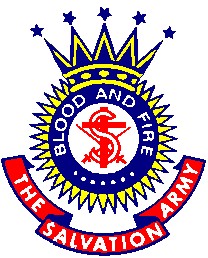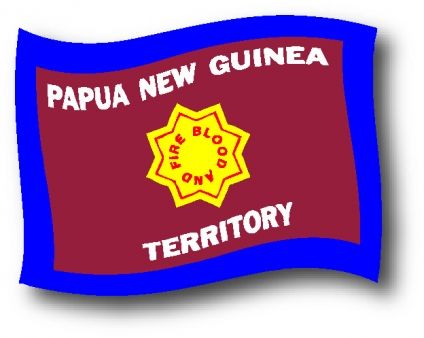Our Terminology
Articles of War (Soldier's Covenant):
The statement of beliefs and promises which every intending soldier is required to sign before enrolment.
'Blood and Fire':
The Salvation Army's motto, referring to the symbolism of the sacrificial blood of Jesus Christ and the purifying, illuminating fire of the Holy Spirit.
Cadet:
A Salvationist undertaking theological and practical training for officership. The first cadets were trained in 1879.
Candidate:
A soldier who has been accepted for officer training.
Congress:
Central gatherings held in divisions, regions, territories or internationally, attended by officers and their fellow Salvationists.
Corps:
A Salvation Army church similar in concept to that of other churches' 'parishes', sometimes comprising several congregations, to share the good news about Jesus Christ and serve the community.
Corps cadet:
A young Salvationist who undertakes a course of Bible study, Salvation Army doctrine and history, and practical training in his/her corps.
Corps sergeant-major:
Similar to the chief 'elder' or lay leader in other Christian denominations, the CSM is the chief local officer for public work who assists the corps officer (CO) with meetings (worship services) and usually takes command and responsibility in the CO's absence.
Crest:
The crest is a meaningful symbol of the Salvationist's beliefs.
Captain William Ebdon designed the crest in 1878 and the only alteration to his original design was the addition of the crown. Its emblems set forth the leading doctrines of The Salvation Army as follows:
The crown speaks of God's reward for His faithful people
The sun (the surround) represents the light and fire of the Holy Spirit
The 'S' stands for salvation from sin
The cross of Jesus stands at the centre of the crest and the Salvationist's faith
The swords represent the fight against sin
The shots (seven dots on the circle) stand for the truths of the Gospel
'Blood and Fire' is the motto of The Salvation Army. This describes the blood of Jesus shed on the cross to save all people, and the fire of the Holy Spirit which purifies believers
Dedication service:
The Salvation Army's equivalent to a christening service, it consists of a public presentation of infants to God. It differs from christening or infant baptism in that the main emphasis is upon specific vows made by the parent/s concerning the child's/childrens upbringing.
Division:
A number of corps grouped together, directed by a divisional commander (similar in responsibility and administrative role to bishops in other churches).
Fellowship:
A locality in which Army work is carried on and where it is hoped a society or corps will develop.
Flag:
Around the world, The Salvation Army flag is a symbol of the Army's war against sin and social evil.
The red on the flag symbolises the blood shed by Christ, the yellow for the fire of the Holy Spirit and the blue for the purity of God the Father.
The flag precedes outdoor activities such as a march of witness. It is used in ceremonies such as the dedication of children and the swearing-in of soldiers. It is sometimes placed on the coffin at the funeral of a Salvationist. The Salvation Army term used to describe the death of a Salvationist is that of the deceased being "promoted to glory". This is a term that is still used and upheld by Salvationists today.
General:
The officer elected (by the High Council) to lead the international Salvation Army. All appointments are made, and all regulations issued, under the General's authority.
Home League:
Inaugurated in 1907, the Home League is a fellowship group designed to influence women in the creation and development of Christian standards in personal home life. Its motto is from the Bible: 'I will live a pure life in my house' (Psalm 101:2b, Good News Bible).
Junior Soldier:
A boy or girl who, having come to faith in Christ and signed the junior soldier's promise, is enrolled as a Salvationist.
League of Mercy/Community Care Ministries:
Commenced in 1892 as the League of Mercy, Community Care Ministries - on a worldwide basis - seeks to respond to spiritual and social needs through visitation in the community in which it is located. It is based on Christ's injuction, 'Whatever you did for one of the least of these brothers of mine, you did for me' (Matthew 25:40, New International Version).
Local Officer:
A soldier appointed to a position of responsibility and authority in the corps; who carries out the duties of the appointment without being separated from his/her regular employment/lifestyle or receiving remuneration from The Salvation Army.
Mercy Seat, Penitent Form or Holiness Table:
A bench or table provided as a place where people can kneel to pray, seeking salvation or sanctification, or making a special consecration of their life to God's will and service. This piece (or combination) of furniture is usually located between the platform and main area of Army halls in much the same way as other Christian churches place altars, as a focal point to remind worshippers of God's reconciling, redeeming presence.
Officer:
A Salvationist who, responding to God's call, is trained and commissioned as a full-time minister of religion of The Salvation Army.
Promotion to glory:
The Army's description of the death of Salvationists, with 'glory' symbolising life after death in God's presence.
Ranks of officers:
Ranks of officers currently in use are as follows: lieutenant, captain, major, lieut-colonel, colonel, commissioner, general.
Red Shield:
The Red Shield is an internationally recognised symbol of Salvation Army service to those in need. It represents the shield we provide to people in need of help, whether it be spiritually, physically, financially or emotionally
Red Shield Appeal:
An annual financial appeal to the general public in many countries, to fund The Salvation Army's social work.
Salvation:
The work of grace which God accomplishes in a repentant person whose trust is in Jesus Christ. The deeper experience of this grace, known as holiness or sanctification, is the outcome of wholehearted commitment to God.
Soldier:
A person who is 'converted', i.e. came to faith in Jesus Christ. Soldiers must be at least 14 years of age and meet with the approval of the census board. They are sworn-in after signing the articles of war.
Swearing-In:
The public enrolment of Salvation Army soldiers.
Territory:
A country, part of a country or several countries combined, in which Salvation Army work is organised under a territorial commander.
Uniform:
Our uniform shows that we are available and willing to serve.
While many denominations of the Christian Church have a distinctive form of dress for the clergy, The Salvation Army is almost unique in its allocation of its distinctively martial apparel for clergy and laity alike. Salvationists advocate the priesthood of all believers, thus the uniform (which relates to a priestly garb) is also worn by non-officers. In a sense, a Salvation Army uniform is a Salvationist's "working clothes" for mission
The Salvationist's uniform currently serves three purposes: internally its use provides a sense of identity and indicates membership; externally it provides a widely recognised symbol of availability and service; internationally it is the most recognised and recognisable cultural icon for Salvationists, part of the glue that holds the denomination together.
The effect of uniform-wearing is to give an extraordinarily high visibility and visual impact in public. The negative effects that Salvationists have to guard against are exclusivity within the Army's congregations and a sense of smugness or spiritual superiority, and complacency (mistaking the wearing of particular garments for being in a right relationship with God).